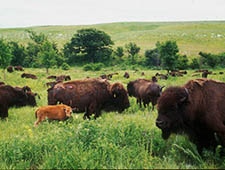
Ecologists know that nitrogen, phosphorus and leaf area play key roles in the productivity of plant communities. But how tightly are they tied together? And are those relationships sustained over different types of landscapes? A recent study of tallgrass prairie communities, building on a previous study of arctic tundra, found leaf area index (LAI) to be strongly correlated to both total foliar nitrogen and total foliar phosphorus in several plant functional types (grass, forb, woody, and sedge) and grazing treatments (cattle, bison, and ungrazed).
These findings suggest that in many kinds of systems, optimal growth requires a consistent ratio of N and P per unit leaf area. Co-limitation, in which higher levels of N may not lead to an increase in primary productivity if not coupled with a similar increase in P, may be more common than ecologists have thought. Furthermore, since researchers can use LAI to infer changes in primary productivity regardless of vegetation type and grazing treatment, they may now also be able to predict plant N and P on an areal basis, using remote sensing. This would make it easier to assess the spatial distribution of these limiting nutrients resulting in more informed predictions about ecosystem productivity and other ecological functions.










